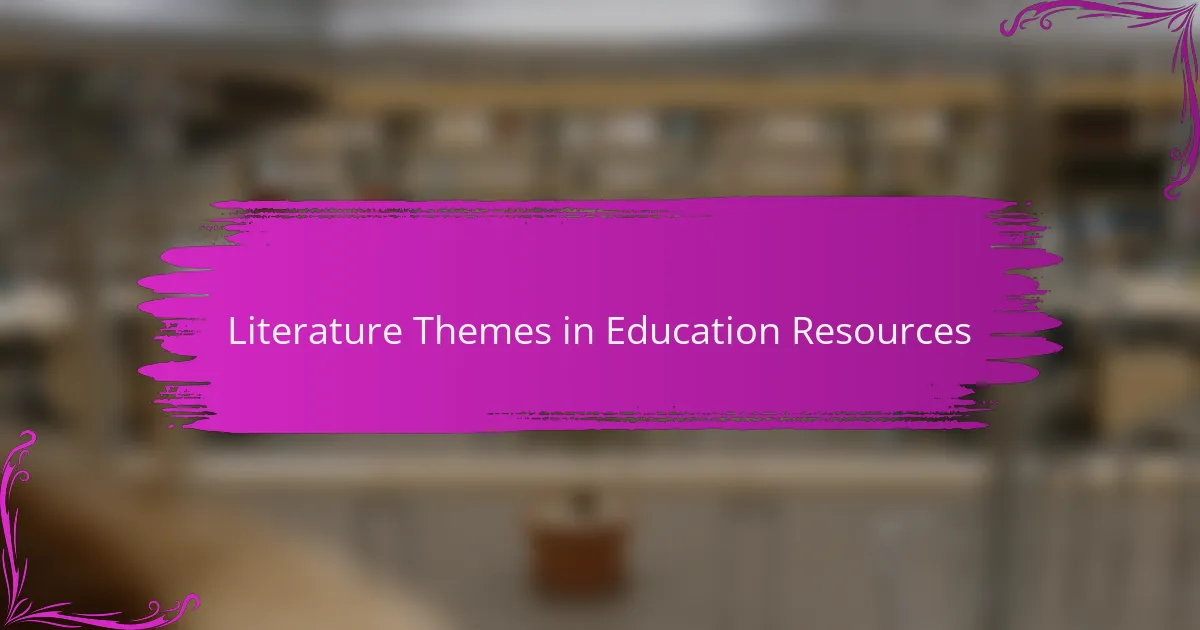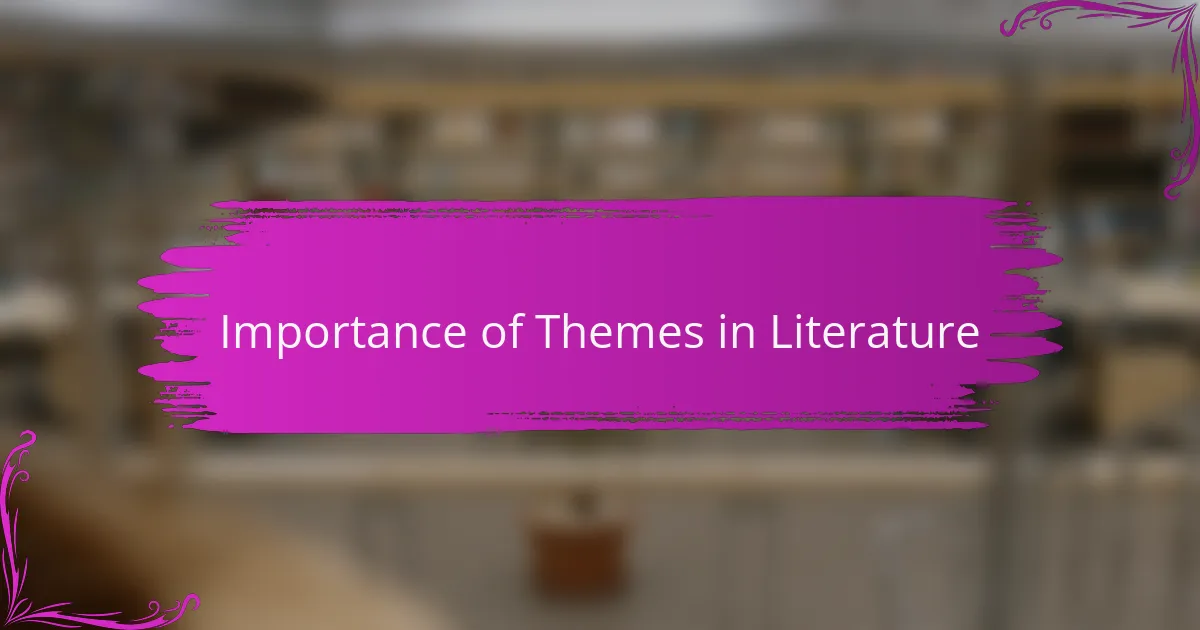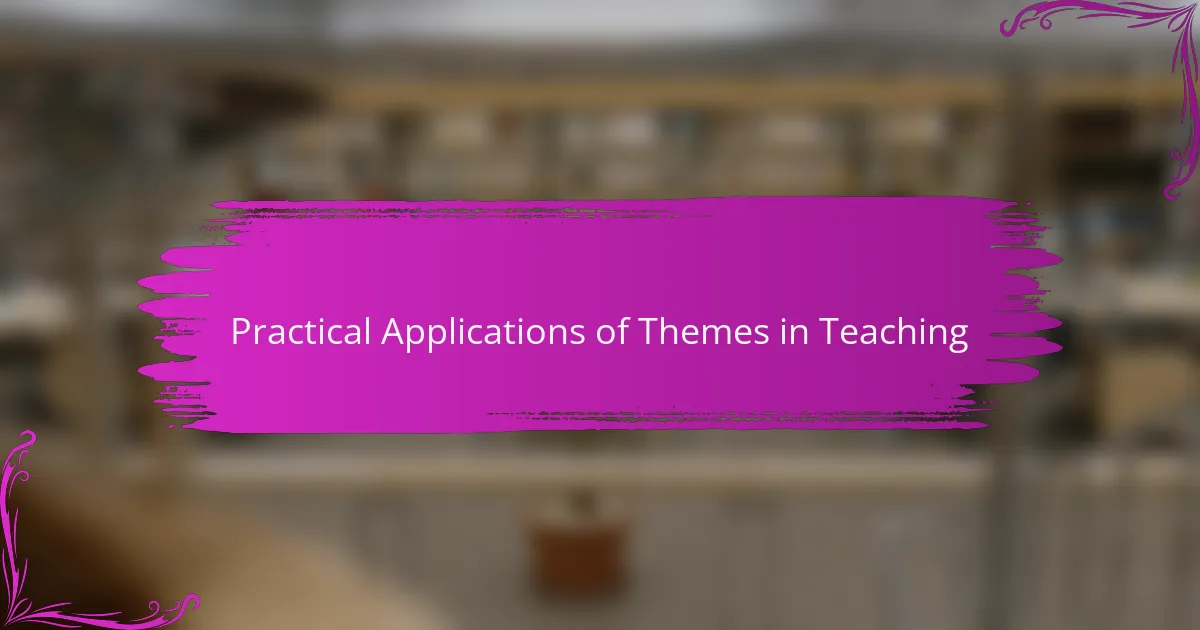Key takeaways
- Themes in literature, such as social injustice and resilience, foster empathy and critical thinking in students, making texts more relevant to their lives.
- Steinbeck’s novels reflect historical and social contexts, prompting readers to connect deeply with characters and their struggles.
- Incorporating themes into teaching practices encourages meaningful discussions, allowing students to relate literature to contemporary issues.
- Personal reflections on literary themes enhance emotional understanding, making the reading experience transformative and relatable.

Literature Themes in Education Resources
When discussing literature themes in educational resources, I find that they often become the gateways to deeper understanding and engagement with the text. For instance, Steinbeck’s exploration of social injustice resonates profoundly with students who may see reflections of their realities within the narrative. I’ve witnessed firsthand how discussions around his works can spark passionate debates and emotional connections, making literature feel more relevant and alive.
Additionally, focusing on themes like family, resilience, and the American Dream in Steinbeck’s novels offers educators a rich tapestry to explore character development and moral dilemmas. These themes help students reflect not only on the characters’ journeys but also on their own lives, fostering an environment of empathy and critical thinking.
To further illustrate these insights, here’s a comparison table highlighting key themes in Steinbeck’s works and their educational implications:
| Theme | Educational Implication |
|---|---|
| Social Injustice | Encourages discussions on equity and empathy |
| American Dream | Promotes critical thinking about individual versus societal aspirations |
| Family and Resilience | Fosters understanding of support systems and personal growth |

Importance of Themes in Literature
Themes in literature serve as the threads that weave intended meanings through a text, making them essential for understanding the author’s vision. I remember reading The Grapes of Wrath in high school; the theme of social injustice struck me deeply. It opened my eyes to the struggles of those around me, prompting me to question how society can overlook such disparities.
Moreover, themes act as mirrors reflecting our own lives and experiences. During my college years, engaging with the theme of the American Dream in Steinbeck’s Of Mice and Men helped me to reevaluate my ambitions and the societal expectations shaping them. This connection not only made the content relatable but also encourages readers to voice their interpretations and feelings, leading to transformative discussions.
Exploring these themes can provoke profound emotional responses, as literature often becomes a safe space for examining difficult truths. I’ve witnessed students become genuinely passionate about their interpretations when they relate themes to contemporary issues. It’s amazing how a single theme can ignite such enthusiasm and critical thinking, don’t you think? By diving into these topics, literature extends beyond mere words on a page; it becomes a catalyst for personal growth and social awareness.

Overview of Steinbeck’s Novels
Steinbeck’s novels are a profound reflection of the American experience during the 20th century. Each story serves as a lens through which we can examine the historical and social context of the times, from the Great Depression’s harsh realities in The Grapes of Wrath to the struggles of migrant workers in Of Mice and Men. I always felt that reading these stories was like stepping into a time capsule, where the struggles and triumphs felt both distant yet intimately familiar.
The depth of his characters is another element that leaves a lasting impression. I remember grappling with the complexities of characters like George and Lennie, whose dreams and disappointments reveal foundational truths about friendship and sacrifice. It’s remarkable how Steinbeck’s ability to craft relatable characters fosters genuine emotional responses, making readers question not only the choices these characters make but also their own paths in life.
Moreover, Steinbeck’s vivid descriptions of both the landscape and the human condition invite us to ponder broader themes. I often found myself captivated by the way his settings reflect the characters’ inner struggles. For example, the barren fields in East of Eden symbolize the moral battles faced by the characters. Doesn’t it make you think about how our surroundings can shape our experiences? Each reading offers new insights, reminding me of the complexities of human nature and the unifying themes that resonate across generations.

Criteria for Selecting Themes
When selecting themes from Steinbeck’s novels, I often look for the underlying social issues presented in his work. Steinbeck had a unique ability to weave together human experiences with broader societal dilemmas, showcasing themes like poverty, community, and the human condition. I find it essential to consider how these elements resonate with my own experiences and societal observations.
Another aspect I prioritize is how well these themes are articulated through character development. Each character in Steinbeck’s novels often embodies specific themes, allowing readers to connect emotionally. For instance, I remember feeling a strong connection to the struggles of characters in “The Grapes of Wrath,” which made the theme of resilience stand out to me personally.
Finally, the historical context of Steinbeck’s works plays a critical role in my selection. Understanding the time period he was writing in, such as the Great Depression, helps me see the relevance of his themes today. I often reflect on how the themes of isolation and hope resonate still, particularly in challenging times.
| Criteria | Description |
|---|---|
| Social Issues | Focus on universal human experiences and societal dilemmas. |
| Character Development | Evaluate how characters exemplify and convey these themes. |
| Historical Context | Consider the time period and its impact on the themes. |

Personal Reflection on Theme Selection
When I first dove into Steinbeck’s novels, I found myself resonating deeply with the themes of struggle and resilience. For instance, in “The Grapes of Wrath,” I couldn’t help but reflect on the hardships faced by the Joad family, which mirrored the challenges many people encounter today. This connection made me realize how timeless and universal Steinbeck’s messages are.
As I explored “Of Mice and Men,” the theme of friendship amidst adversity struck a chord with me. I remembered my own friendships during tough times, which enriched my understanding of George and Lennie’s bond. These personal connections made theme selection not just an academic exercise, but a profound experience that evoked emotion and reflection.
Here is a comparison table showcasing the themes I selected from two novels:
| Novel | Key Themes |
|---|---|
| The Grapes of Wrath | Struggle, Resilience, Community |
| Of Mice and Men | Friendship, Dreams, Loneliness |

Practical Applications of Themes in Teaching
Incorporating the themes from Steinbeck’s novels into teaching practices opens a world of relatable discussions. For example, when I present the theme of social injustice, I often ask students to share their thoughts on modern societal issues. This not only helps them connect Steinbeck’s narratives to their own lives but also encourages them to think critically about the world around them.
Additionally, using group activities centered around themes such as resilience can create a supportive classroom environment. I’ve seen students form bonds as they discuss personal stories of overcoming challenges, mirroring the struggles faced by Steinbeck’s characters. This exchange fosters empathy and often leads to rich, heartfelt discussions that enhance their understanding of both the texts and each other.
Moreover, I believe that connecting literary themes to contemporary events can make literature feel alive and relevant in the classroom. I often share current news articles that reflect the same challenges present in Steinbeck’s works, prompting students to analyze parallels. These discussions not only deepen their appreciation of literature but also empower them to articulate their perspectives and become more engaged citizens.




